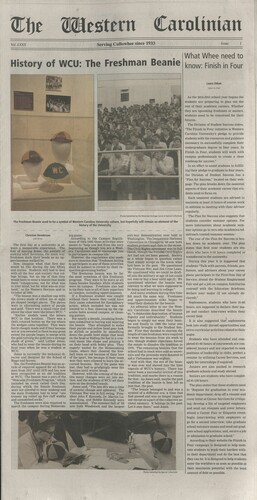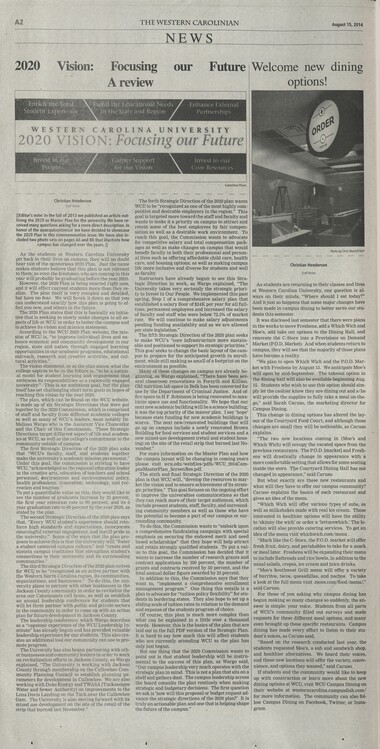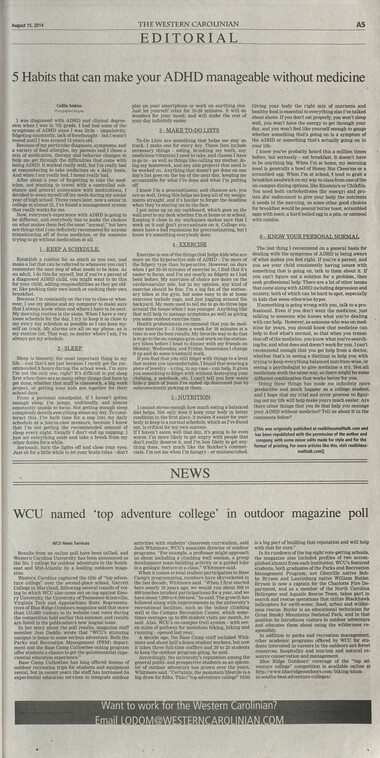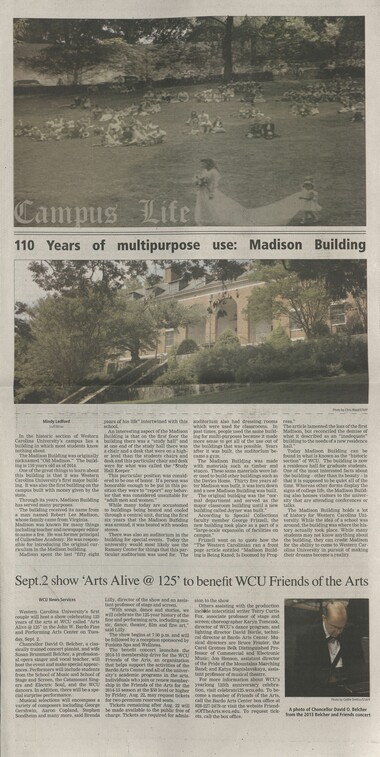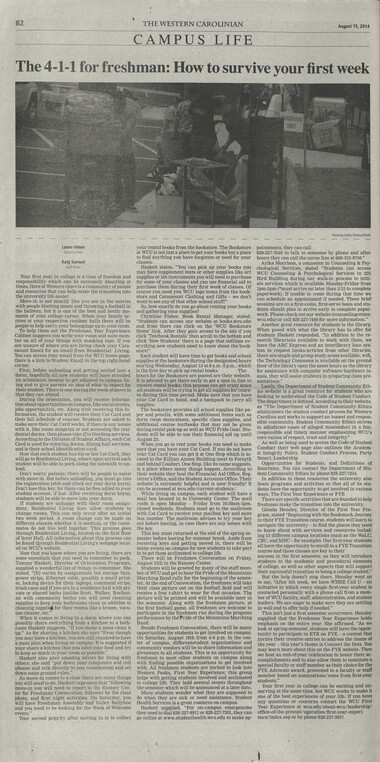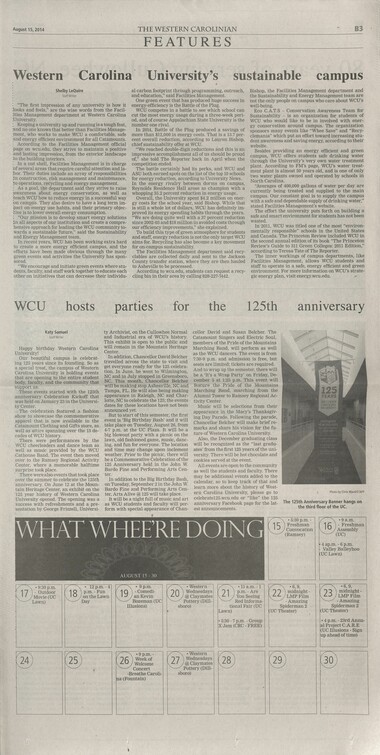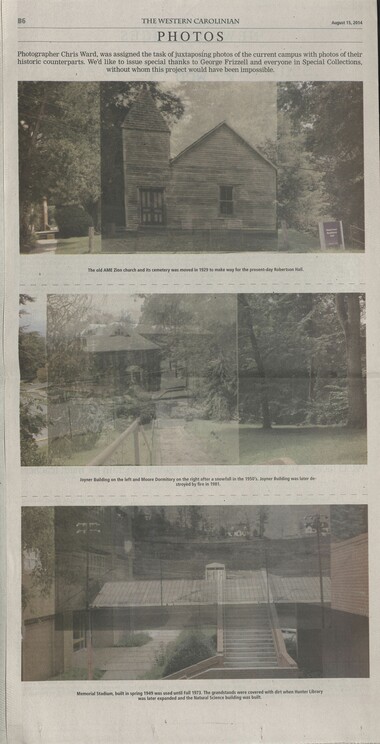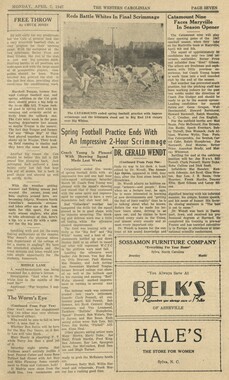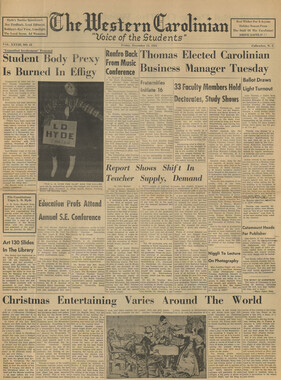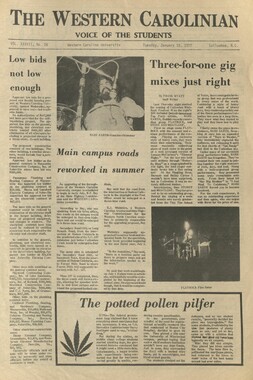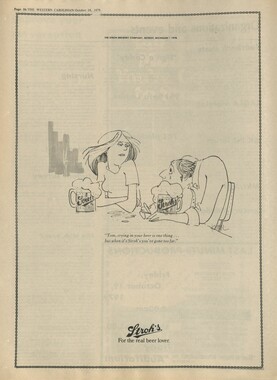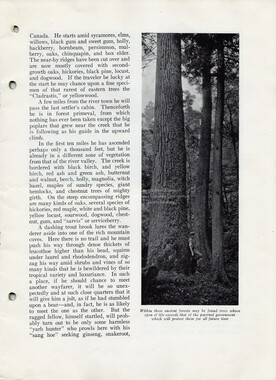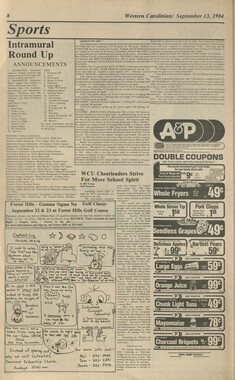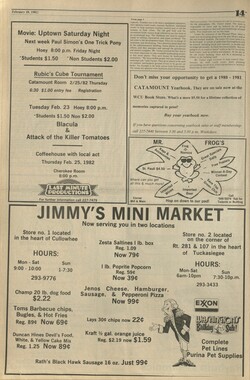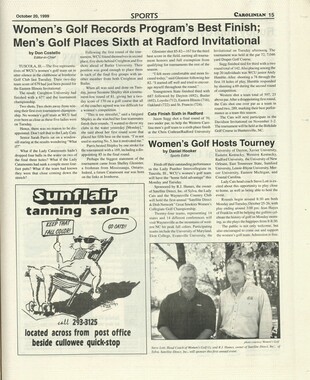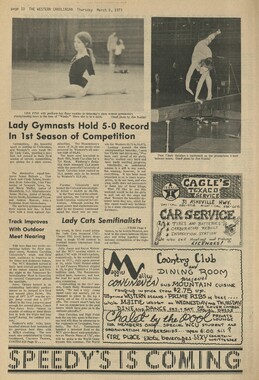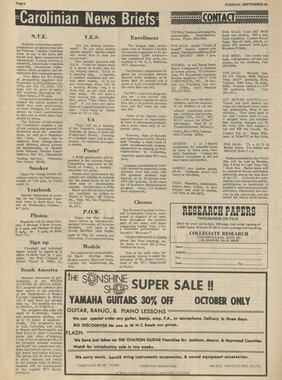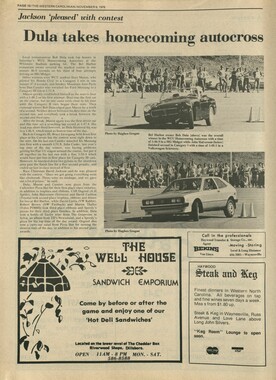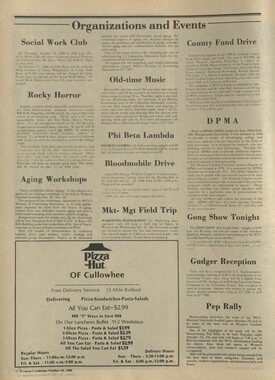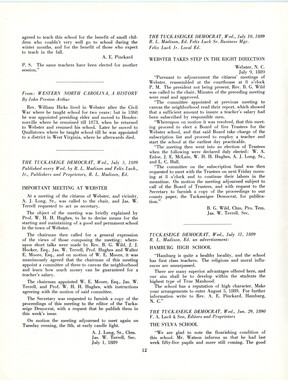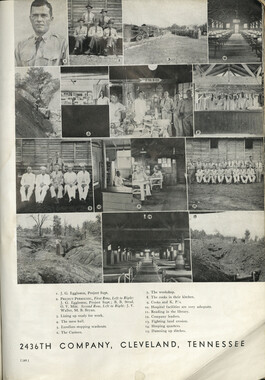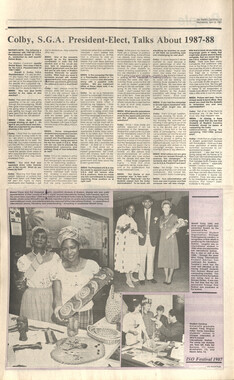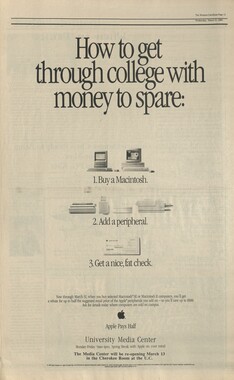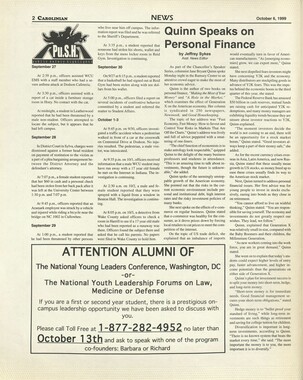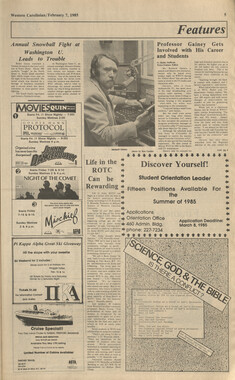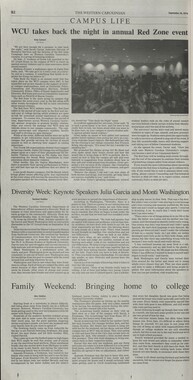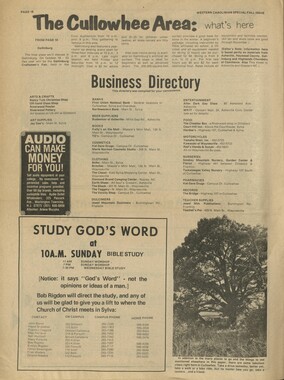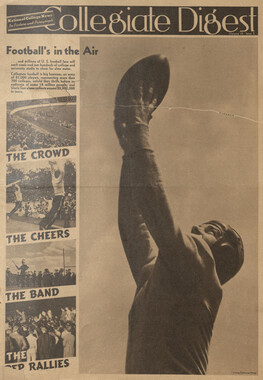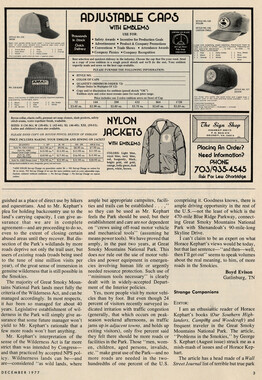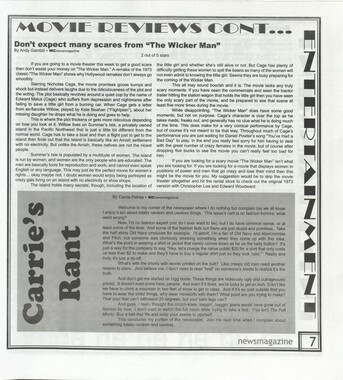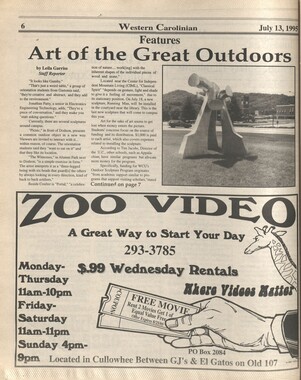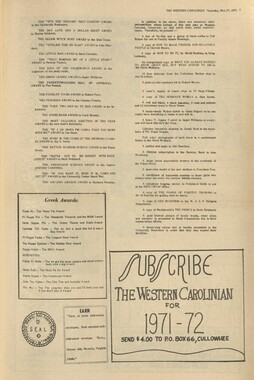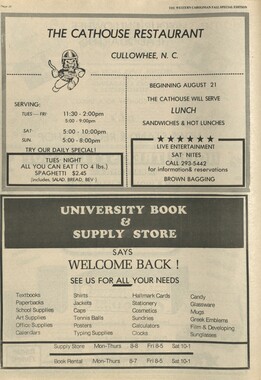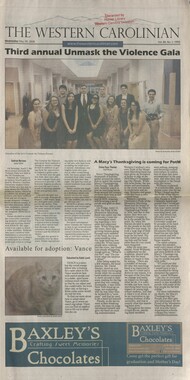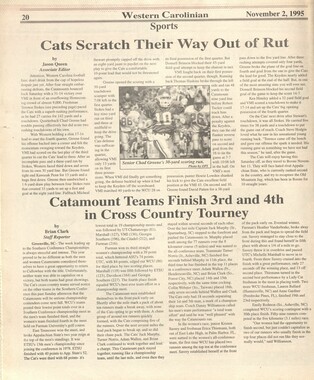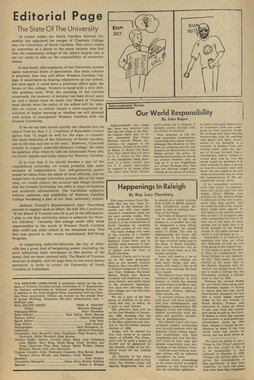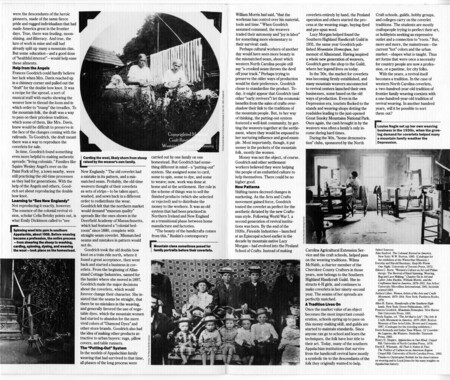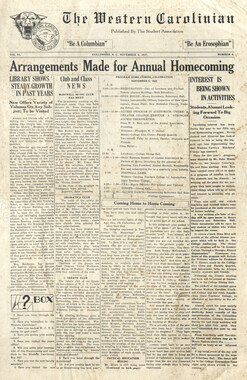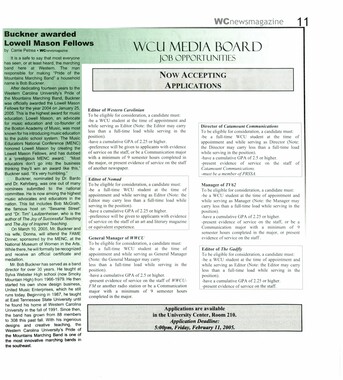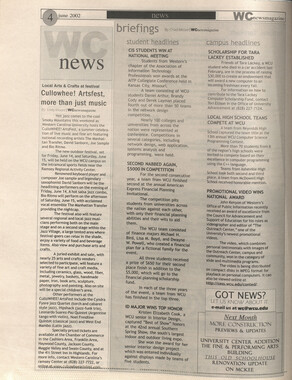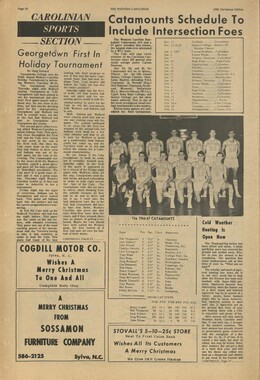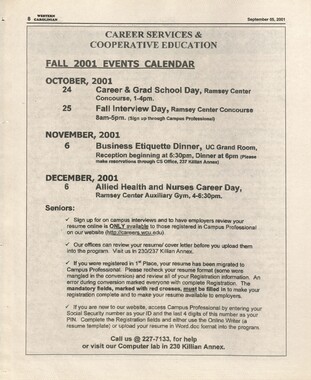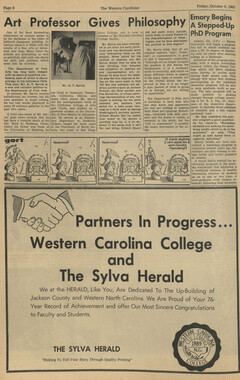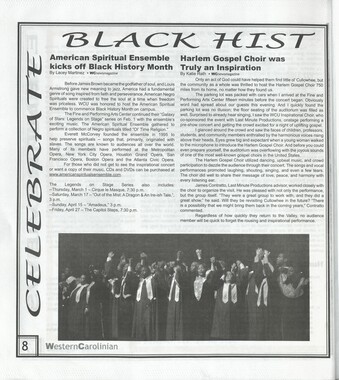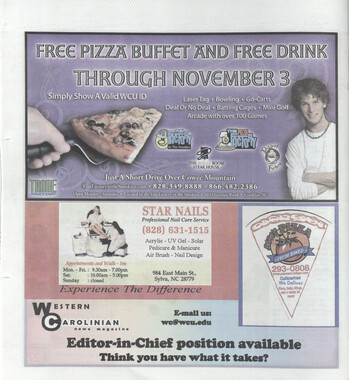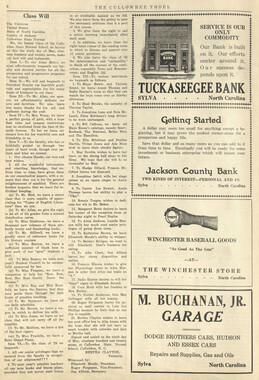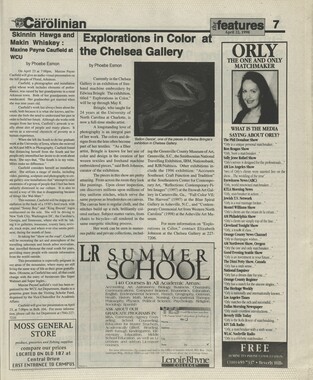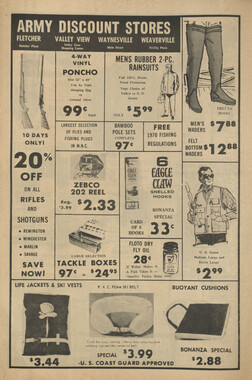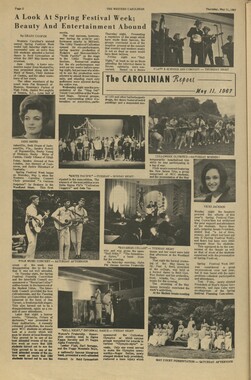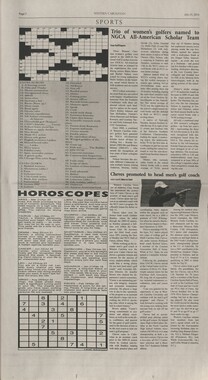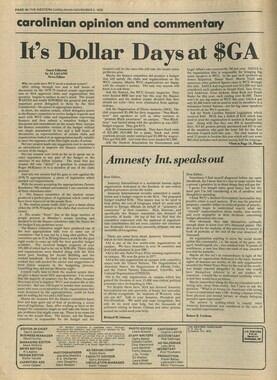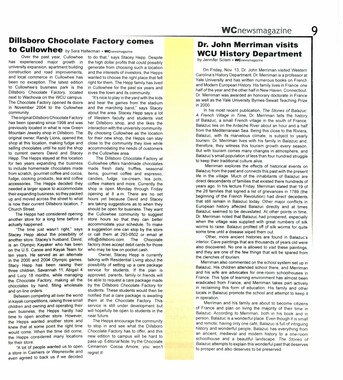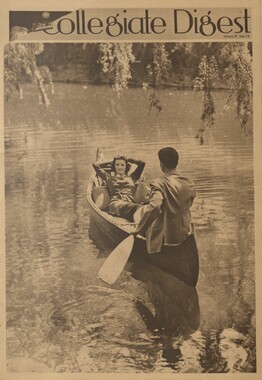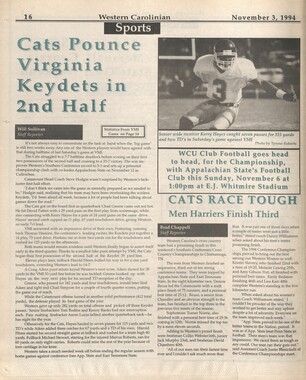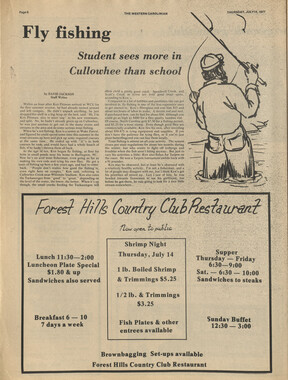Western Carolina University (21)
View all
- Canton Champion Fibre Company (2308)
- Cherokee Traditions (291)
- Civil War in Southern Appalachia (165)
- Craft Revival (1942)
- George Masa Collection (135)
- Great Smoky Mountains - A Park for America (2901)
- Highlights from Western Carolina University (422)
- Horace Kephart (941)
- Journeys Through Jackson (159)
- LGBTQIA+ Archive of Jackson County (85)
- Oral Histories of Western North Carolina (314)
- Picturing Appalachia (6798)
- Stories of Mountain Folk (413)
- Travel Western North Carolina (153)
- Western Carolina University Fine Art Museum Vitreograph Collection (129)
- Western Carolina University Herbarium (92)
- Western Carolina University: Making Memories (738)
- Western Carolina University Publications (2491)
- Western Carolina University Restricted Electronic Theses and Dissertations (146)
- Western North Carolina Regional Maps (71)
- World War II in Southern Appalachia (131)
University of North Carolina Asheville (6)
View all
- Allanstand Cottage Industries (62)
- Appalachian National Park Association (53)
- Bennett, Kelly, 1890-1974 (1463)
- Berry, Walter (76)
- Brasstown Carvers (40)
- Carver, George Washington, 1864?-1943 (26)
- Cathey, Joseph, 1803-1874 (1)
- Champion Fibre Company (233)
- Champion Paper and Fibre Company (297)
- Cherokee Indian Fair Association (16)
- Cherokee Language Program (22)
- Crowe, Amanda (40)
- Edmonston, Thomas Benton, 1842-1907 (7)
- Ensley, A. L. (Abraham Lincoln), 1865-1948 (275)
- Fromer, Irving Rhodes, 1913-1994 (70)
- George Butz (BFS 1907) (46)
- Goodrich, Frances Louisa (120)
- Grant, George Alexander, 1891-1964 (96)
- Heard, Marian Gladys (60)
- Kephart, Calvin, 1883-1969 (15)
- Kephart, Horace, 1862-1931 (313)
- Kephart, Laura, 1862-1954 (39)
- Laney, Gideon Thomas, 1889-1976 (439)
- Masa, George, 1881-1933 (61)
- McElhinney, William Julian, 1896-1953 (44)
- Niggli, Josephina, 1910-1983 (10)
- North Carolina Park Commission (105)
- Osborne, Kezia Stradley (9)
- Owens, Samuel Robert, 1918-1995 (11)
- Penland Weavers and Potters (36)
- Roberts, Vivienne (15)
- Roth, Albert, 1890-1974 (142)
- Schenck, Carl Alwin, 1868-1955 (1)
- Sherrill's Photography Studio (2565)
- Southern Highland Handicraft Guild (127)
- Southern Highlanders, Inc. (71)
- Stalcup, Jesse Bryson (46)
- Stearns, I. K. (213)
- Thompson, James Edward, 1880-1976 (226)
- United States. Indian Arts and Crafts Board (130)
- USFS (683)
- Vance, Zebulon Baird, 1830-1894 (1)
- Weaver, Zebulon, 1872-1948 (58)
- Western Carolina College (230)
- Western Carolina Teachers College (282)
- Western Carolina University (2008)
- Western Carolina University. Mountain Heritage Center (18)
- Whitman, Walt, 1819-1892 (10)
- Wilburn, Hiram Coleman, 1880-1967 (73)
- Williams, Isadora (3)
- Cain, Doreyl Ammons (0)
- Crittenden, Lorraine (0)
- Rhodes, Judy (0)
- Smith, Edward Clark (0)
- Appalachian Region, Southern (2924)
- Asheville (N.C.) (1941)
- Avery County (N.C.) (26)
- Blount County (Tenn.) (195)
- Buncombe County (N.C.) (1672)
- Cherokee County (N.C.) (283)
- Clay County (N.C.) (556)
- Graham County (N.C.) (236)
- Great Smoky Mountains National Park (N.C. and Tenn.) (525)
- Haywood County (N.C.) (3569)
- Henderson County (N.C.) (70)
- Jackson County (N.C.) (4913)
- Knox County (Tenn.) (35)
- Knoxville (Tenn.) (13)
- Lake Santeetlah (N.C.) (10)
- Macon County (N.C.) (420)
- Madison County (N.C.) (215)
- McDowell County (N.C.) (39)
- Mitchell County (N.C.) (135)
- Polk County (N.C.) (35)
- Qualla Boundary (982)
- Rutherford County (N.C.) (76)
- Swain County (N.C.) (2182)
- Transylvania County (N.C.) (270)
- Watauga County (N.C.) (12)
- Waynesville (N.C.) (86)
- Yancey County (N.C.) (72)
- Aerial Photographs (3)
- Aerial Views (60)
- Albums (books) (4)
- Articles (1)
- Artifacts (object Genre) (228)
- Bibliographies (1)
- Biography (general Genre) (2)
- Cards (information Artifacts) (38)
- Clippings (information Artifacts) (191)
- Copybooks (instructional Materials) (3)
- Crafts (art Genres) (622)
- Depictions (visual Works) (21)
- Design Drawings (1)
- Drawings (visual Works) (185)
- Envelopes (73)
- Exhibitions (events) (1)
- Facsimiles (reproductions) (1)
- Fiction (general Genre) (4)
- Financial Records (12)
- Fliers (printed Matter) (67)
- Glass Plate Negatives (381)
- Guidebooks (2)
- Internegatives (10)
- Interviews (815)
- Land Surveys (102)
- Letters (correspondence) (1013)
- Manuscripts (documents) (618)
- Maps (documents) (177)
- Memorandums (25)
- Minutes (administrative Records) (59)
- Negatives (photographs) (6090)
- Newsletters (1290)
- Newspapers (2)
- Notebooks (8)
- Occupation Currency (1)
- Paintings (visual Works) (1)
- Pen And Ink Drawings (1)
- Periodicals (193)
- Personal Narratives (10)
- Photographs (12976)
- Plans (maps) (1)
- Poetry (5)
- Portraits (4568)
- Postcards (329)
- Programs (documents) (181)
- Publications (documents) (2443)
- Questionnaires (65)
- Relief Prints (26)
- Sayings (literary Genre) (1)
- Scrapbooks (282)
- Sheet Music (2)
- Slides (photographs) (402)
- Songs (musical Compositions) (2)
- Sound Recordings (796)
- Specimens (92)
- Speeches (documents) (18)
- Tintypes (photographs) (8)
- Transcripts (322)
- Video Recordings (physical Artifacts) (23)
- Text Messages (0)
- A.L. Ensley Collection (275)
- Appalachian Industrial School Records (7)
- Appalachian National Park Association Records (336)
- Axley-Meroney Collection (2)
- Bayard Wootten Photograph Collection (20)
- Bethel Rural Community Organization Collection (7)
- Blumer Collection (5)
- C.W. Slagle Collection (20)
- Canton Area Historical Museum (2110)
- Carlos C. Campbell Collection (462)
- Cataloochee History Project (64)
- Cherokee Studies Collection (4)
- Daisy Dame Photograph Album (5)
- Daniel Boone VI Collection (1)
- Doris Ulmann Photograph Collection (112)
- Elizabeth H. Lasley Collection (1)
- Elizabeth Woolworth Szold Fleharty Collection (4)
- Frank Fry Collection (95)
- George Masa Collection (173)
- Gideon Laney Collection (452)
- Hazel Scarborough Collection (2)
- Hiram C. Wilburn Papers (28)
- Historic Photographs Collection (236)
- Horace Kephart Collection (861)
- Humbard Collection (33)
- Hunter and Weaver Families Collection (1)
- I. D. Blumenthal Collection (4)
- Isadora Williams Collection (4)
- Jesse Bryson Stalcup Collection (47)
- Jim Thompson Collection (224)
- John B. Battle Collection (7)
- John C. Campbell Folk School Records (80)
- John Parris Collection (6)
- Judaculla Rock project (2)
- Kelly Bennett Collection (1482)
- Love Family Papers (11)
- Major Wiley Parris Civil War Letters (3)
- Map Collection (12)
- McFee-Misemer Civil War Letters (34)
- Mountain Heritage Center Collection (4)
- Norburn - Robertson - Thomson Families Collection (44)
- Pauline Hood Collection (7)
- Pre-Guild Collection (2)
- Qualla Arts and Crafts Mutual Collection (12)
- R.A. Romanes Collection (681)
- Rosser H. Taylor Collection (1)
- Samuel Robert Owens Collection (94)
- Sara Madison Collection (144)
- Sherrill Studio Photo Collection (2558)
- Smoky Mountains Hiking Club Collection (616)
- Stories of Mountain Folk - Radio Programs (374)
- The Reporter, Western Carolina University (510)
- Venoy and Elizabeth Reed Collection (16)
- WCU Gender and Sexuality Oral History Project (32)
- WCU Mountain Heritage Center Oral Histories (25)
- WCU Oral History Collection - Mountain People, Mountain Lives (71)
- WCU Students Newspapers Collection (1923)
- Western North Carolina Tomorrow Black Oral History Project (69)
- William Williams Stringfield Collection (2)
- Zebulon Weaver Collection (109)
- African Americans (390)
- Appalachian Trail (35)
- Artisans (521)
- Cherokee art (84)
- Cherokee artists -- North Carolina (10)
- Cherokee language (21)
- Cherokee pottery (101)
- Cherokee women (208)
- Church buildings (190)
- Civilian Conservation Corps (U.S.) (111)
- College student newspapers and periodicals (2012)
- Dams (107)
- Dance (1023)
- Education (222)
- Floods (61)
- Folk music (1015)
- Forced removal, 1813-1903 (2)
- Forest conservation (220)
- Forests and forestry (1196)
- Gender nonconformity (4)
- Great Smoky Mountains National Park (N.C. and Tenn.) (181)
- Hunting (45)
- Landscape photography (25)
- Logging (119)
- Maps (83)
- Mines and mineral resources (8)
- North Carolina -- Maps (18)
- Paper industry (38)
- Postcards (255)
- Pottery (135)
- Railroad trains (72)
- Rural electrification -- North Carolina, Western (3)
- School integration -- Southern States (2)
- Segregation -- North Carolina, Western (5)
- Slavery (5)
- Sports (452)
- Storytelling (243)
- Waterfalls -- Great Smoky Mountains (N.C. and Tenn.) (66)
- Weaving -- Appalachian Region, Southern (280)
- Wood-carving -- Appalachian Region, Southern (328)
- World War, 1939-1945 (173)
Western Carolinian Volume 80 Number 01
Item
Item’s are ‘child’ level descriptions to ‘parent’ objects, (e.g. one page of a whole book).
-
-
Che Western Carolinian Vol. LXXX Serving Cullowhee since 1933 Issue : 1 What Whee need to History of WCU: The Freshman Beanie know: Finish in Four Photos Submitted by the Mountain Heritage Center & Ae Collections The Freshman Beanie used to be a symbol of Western Carolina University culture, but hopefully will remain an element of Lge Christian Henderson Staff Writer The first day at a university is al- ways a memorable experience. The fear of leaving home, the anxiety of making adult decisions, the meek way freshmen duck their heads aS an up- perclassman walked by. Now, imagine what that first day would be like during the late fifties and sixties. Students still had to deal with all the fear and anxiety that col- lege brings, but on top of that they would have to wear a beanie that made them conspicuous, not for what was in your mind, but for what was on your head, as the. Western Horizon said in October of 1984. The beanie was a shallow cap with the crown made of either six or eight pie shaped (wedge) pieces. The pieces were in alternating colors of purple and gold. There was a small visor and above the visor were the letters WCU. Earlier models used the letters WCC in that location. There was a cloth covered button on the top where the wedges came together. They were fairly cheaply made and if they became wet or you sweated in them to any great, extent the purple began to merge with the gold turning the gold into a strange shade of green. said Luther Jones, who had to wear the beanie during its _ final year when he was a student at WCU. Jones is currently the technical di- rector and designer for the School of Stage and Screen. Yes, the Freshman Beanie was an ar- ticle of required apparel for all fresh- man from 1957 until 1970 and has now been recognized as an old tradition at WCU. The beanie was a part of the Welcome Freshmen Program, which included an event called Garb Day, during which the female freshman were not allowed to wear makeup and the male freshmen had to wear one trouser leg rolled up five cuff widths and unmatched socks. The freshmen were also reuuired to march the campus during Homecom- history of the University. ing game. According to the Campus Regula- tions of 1964-1965 these activities were meant to help you feel from the very beginning as though you are a West- -ern Carolinian and to encourage you to: participate in campus life. However, the regulations also made sure to mention that freshmen failing to participate in any of these activities shall be subject to review by their re- spective governing bodies. The freshman beanie was by far the most notorious of this freshman program. They were to be worn at all times besides Sundays while students were on campus. Freshmen also had to tip their hats to all of their superiors on campus, including upperclassmen. . If a freshman student was caught without their beanie they could have their name submitted for disciplinary action, which included but was not limited to: a fine, cleaning up the cig- arette butts around campus, or clean- ing gutters. For nearly a decade, incoming fresh- men submitted to buying and wearing the beanie. They attempted to make their purple and yellow head gear look as stylish as possible by smoothing down the poofie bowl shape that went on the head or folding the hat in a cres- cent moon like shape and pinning it on their head with bobby pins. They eagerly waited for the Homecoming Game, where they cheered the foot- ball team on not because of their love of the sport, but because if their team _ won they were allowed to burn the ac- cursed beanies. But if the game was lost, they had to grudgingly wear the beanies until winter break. However, with the coming of the six- ties many changes were set into mo- tion, and the students of WCU set their eyes on the dreaded beanie. Jones said, The late 60s was a time of societal change and upheaval. The Vietnam War was in full swing. Pres- ident John F. Kennedy, Dr. Martin Lu- ther King, and Bobbie Kennedy were assassinated. The summer/fall of 69 saw both Woodstock and the largest anti-war demonstration ever held in Washington. The Democratic National Convention in Chicago in 68 saw both student protests and riots in the street. The Civil Rights movement was in full bloom, though the Federal Civil Rights Act had not yet been passed. Society as a whole began to question rather than simply accept as the norm what had been in the past. We questioned the Vietnam War, and Jim Crow Laws. We questionedwhy we could be: draft- ed into the military at age 18 but could not vote or buy a beer until age 21. We questioned whether the beanie was relevant to what we were supposed to be doing and learning in college. And many students during this time felt much the same way. Freshmen and upperclassmen alike began to voice'their disdain for the beanie. An editorial letter to our the West- ern Carolinian described the beanie a deplorable deprivation of human dignity and individuality. Students began to simply not wear their bean- ies and finally in 1969 the issue was formally brought to the Student Sen- ate. First they decided to shorten the length of time freshman were required to wear the beanies from six week to two, though student objections forced the senate to dissolve the tradition in 1970. The remaining beanies that the school had in stock were sold as souve- nirs and the proceeds were donated to aid a Vietnamese war orphan. And with that, the era of the bean- ie was over and shoved into the time capsule of WCUs history.. There has never been a successful revival of this tradition, and maybe there is,a reason for that. As Jones said, maybe the past tradition of the beanie is best left as. * just that, the past. The beanie belonged to and was a symbol of a different era, a time that had passed and was no longer import- ant except as a.part of the collective so- cietal memory. It belongs in the past. Let it stay there, said Jones. Photos Submitted by Special Collections Laura Odom Editor-In-Chief As the 2014-2015 school year begins the students are preparing to plan out the rest of their academic careers. Whether they are upcoming freshmen or seniors, students-need to be concerned for their futures. The Division of Student Success states, The Finish in Four initiative is Western Carolina Universitys pledge to provide students with the resources and guidance necessary to successfully complete their undergraduate degree in four years. In Finish in Four, students will work with campus eae: to create a clear roadmap for success. In an effort to assist students in fulfill- ing their pledge to graduate in four years, the Division of Student Success has a Plan for Success, located on their web- page. The plan breaks down the essential aspects of their academic career that stu- dents need to focus on. Each semester students are advised to maintain at least 15 hours of course work in addition to meeting with their advisor regularly. The Plan for Success also suggests that students consider summer options. For more information about academic sum- mer options go to wcu.edu/academics/ed- outreach/conted/summer-session/. The rest of the Plan for Success is bro- ken down by academic year. The plan states that first year students are stu- dents who have 0-30 hours completed or transferred to the university. During this year it is Suggested that students Talk with parents, friends, pro- .fessors, and advisors about your career plans; participate in the First-Year Day of Service; attend the Student Employment Fair and get a job on campus; familiarize yourself with the Education Briefcase; declare your major ae not already de- clared). Sophomores, students who have 31-60 hours, are supposed to declare their ma- jor and conduct interviews within their career field. It is also suggested that beccuores Jook into study abroad opportunities and extra-curricular activities related to their major. Students who have attended and com- pleted 61-90 hours of coursework are con- sidered juniors and are expected to seek positions of leadership in clubs, perfect a -resume by utilizing Career Services, and apply for internships if required. Juniors are also pushed to research graduate schools and study abroad. Seniors are students who We complet- ed 91-120 hours. : The plan states that these students need to Register for graduation in your aca- demic department; drop off a rsum and cover letter at Career Services for critiqu- ing; develop a listof targeted employers and send out rsums and cover letters; attend a Career Fair or Etiquette event; begin interviewing with employers or go for a second interview; take graduate school entrance exams and send out grad- uate school applications; and, secure a job or admission to graduate school. According to their website the Finish in Four campaign is designed to help moti- vate students to'work their hardest with- in their department and do the best that they can be. It is designed to help students enter the workforce as soon as possible at their maximum potential with the least amount of debt as possible.
Object
Object’s are ‘parent’ level descriptions to ‘children’ items, (e.g. a book with pages).
-
The Western Carolinian is Western Carolina University's student-run newspaper. The paper was published as the Cullowhee Yodel from 1924 to 1931 before changing its name to The Western Carolinian in 1933.
-

